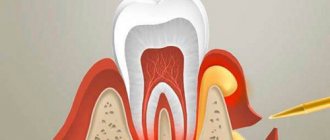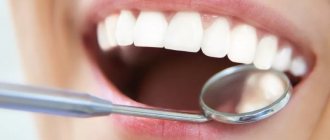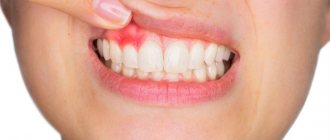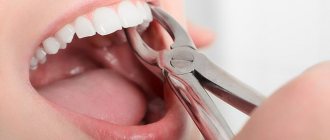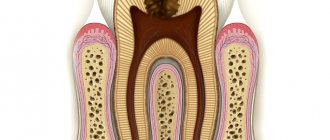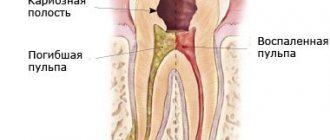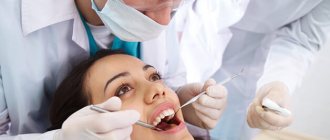When to see a doctor
Since an abscess is an infectious disease, it has pronounced symptoms. You need to go to a specialist as early as possible. An infection diagnosed in time is easier to treat. Evidence of the spread of infection may include:
- A whitish or reddish swelling on the gum.
- Spread of swelling from the gums to the soft tissues of the face.
- Formation of an ulcer with purulent contents at the site of swelling.
- Severe throbbing pain while brushing teeth or eating.
- The appearance of an unpleasant odor from the mouth, which cannot be eliminated by ordinary daily hygiene products.
- Bitter taste in the mouth.
If there is no treatment and the infection continues to spread, general symptoms will also appear. Body temperature rises, the patient may complain of sleep disturbances, lack of appetite, and depression.
If even some of these symptoms appear, come for a consultation with a dentist at the ARDC clinic. The doctor will conduct a diagnosis and clarify the diagnosis.
Treatment of the disease
You should not try to cure a purulent “bump” on your own. Therapy should be carried out by an experienced dentist. First, the specialist carries out an examination and carries out the necessary diagnostic measures. Then he proceeds to opening the purulent formation. To do this, he uses a scalpel or laser beams. Since the drainage procedure is performed under local anesthesia, the patient does not feel pain.
The next step is to wash the wound and treat it with antiseptics, and apply antibacterial compounds. It also happens that drainage is installed in the affected area for several days to avoid re-accumulation of pus.
Afterwards, the tooth is treated or pulled out. In the first case, the nerve is removed. To do this, medicine is put into the unit and after a few days the dead nerve is removed. Afterwards, the canals are cleaned and sealed. Filling material or an individually made inlay is placed on top.
A tooth is pulled out only in advanced cases, when the roots have become unusable and cannot be treated. To prevent this, you need to see a doctor in a timely manner, and not hope that the disease will go away on its own.
If the patient complains of acute and pronounced pain, he is prescribed a painkiller. Most often these are tablets, but it is also possible to use a special anesthetic gel.
In order to achieve a guaranteed victory over inflammation and prevent recurrence of the abscess, the patient is also prescribed an antibiotic. The average course for the described diagnosis is from five to seven days. It is unacceptable to interrupt it in the middle because the condition has improved - the disease may return.
Local treatment, carried out at home after the dental surgeon has opened the abscess, consists of applying compresses with antibacterial compounds and performing therapeutic rinses. These procedures stimulate regeneration and accelerate tissue renewal.
Why does a tooth abscess develop?
The main cause of abscess development is bacteria. They are always present in the oral cavity, but in order for an infectious process to develop, provoking factors are needed. The development of an abscess can be provoked by:
- Violation of the rules of daily hygiene. Bacteria multiply quickly in the favorable environment of dental plaque. When there are a lot of them, a pathological process develops.
- Dental procedures. During tooth extraction, an antiseptic treatment of the oral cavity is performed. When this treatment is insufficient or the procedure was carried out in violation of antiseptic rules, pathogenic bacteria can penetrate the tissue.
The risk of developing a tooth abscess increases if the patient has a weakened immune system or has systemic diseases, for example, diabetes, cancer. Chronic tonsillitis often provokes the development of a purulent process. This is due to the fact that with chronic inflammation of the upper respiratory tract, there is a focus of infection in the body. It may spread to other areas.
Patients with dental problems are also at risk:
- Caries.
- Mechanical damage to the enamel (chips, cracks).
- Periodontal diseases.
- Gingivitis.
Reasons for the development of inflammation
The main reason for the appearance of a focus of pus is inflammation that was previously present inside the tooth or in the periodontal tissues, and, accordingly, was not cured. We are talking about deep caries, pulpitis, periodontitis, periodontitis or periostitis - gumboil. But besides this, the reasons may be the following:
- poorly treated diseases of the gums and teeth are the number one reason,
- damage to teeth - chips or fractures through which the inflammatory process spreads inside and outside the tooth, i.e. infection,
- infectious ENT diseases: flu, sore throat - in such situations, the infection spreads to the jaw tissue through the bloodstream,
- infection during various manipulations in the oral cavity, as well as lack of sterility: poor sterilization of dental instruments can cause the development of a serious infection, for example, when administering anesthesia.
Types of abscess
The type of abscess is determined by its location. Based on this feature, periodontal and periapical types are distinguished. Both can occur in acute or chronic form.
- Periodontal abscess. Develops in the space between the gum and the crown of the tooth. In the acute form there are pronounced symptoms - an abscess on the gum, severe pain when closing the teeth. In the chronic form, such pronounced symptoms are not observed. In case of chronic periodontal abscess of a tooth, a fistula develops at the site of purulent inflammation.
- Periapical abscess. The source of infection is located inside the tooth. Often this type of disease develops as a complication of periodontal disease. The process proceeds as follows. Pus begins to accumulate at the top of the tooth root. If the suppuration is deep and the pus cannot come out, it continues to spread inside the gums, under the mucous membranes. The bone is gradually affected and begins to deteriorate.
Symptoms
When inflammation occurs, aching, throbbing pain appears in the area of the tooth affected by the abscess.
Symptoms of a tooth abscess are pronounced and appear as:
- Aching, constant pain in the area of the damaged tooth.
- The process of chewing food causes acute pain.
- Cold or hot food causes an acute reaction.
- Toothache may be accompanied by fever and chills.
- There is sleep disturbance and lack of appetite.
- The gums around the diseased tooth become very swollen and become bright red.
- The lymph nodes in the neck area become greatly enlarged as they react to the inflammatory process.
- The mouth may give off a putrid odor
- If the abscess is advanced, the tooth may change color.
After tooth extraction
Tooth extraction is a dental operation during which the gums are injured. If antiseptic rules have been violated or the patient does not provide the necessary postoperative care, infection can enter the wound. Bacteria will multiply quickly. Suppuration forms. If there is no treatment, the abscess affects the soft tissue.
Suppuration as a result of medical error after removal is rare. At the ARDC clinic, dentists use modern equipment, consumables, and medications. You can be confident in the quality of the procedure and compliance with the treatment protocol.
Improper postoperative care is a more common cause of abscess after removal. After the operation, the dentist must give recommendations on how to care for the wound. Careful adherence to all these rules will reduce the risk of suppuration at the site of the extracted tooth.
Complications
If the abscess of the affected tooth is not treated in time, the infection can cause complications: the root of the tooth dies, and the infection can affect the remaining teeth, soft tissues and jaw bone.
Sometimes, with a tooth abscess, the purulent pulp ruptures and pus enters the body, which can cause various chronic diseases.
Prevention and treatment
Abscess prevention is simple. It is enough to follow the rules of daily oral hygiene and regularly come for examinations to the dentist.
If an abscess does form, it should be treated by a doctor. Even if the abscess opened on its own. Usually, after the pus is released, the pain goes away, and the person considers the problem solved. But even in this case, there is a risk that the infection continues to develop deep in the soft tissues. A visit to the dentist is a must.
Various methods are used to treat an abscess:
- Therapeutic antibacterial treatment. Antibiotics are not always used. Which drugs will best cope with the problem depends on the clinical picture. Usually in the early stages you can do without potent drugs.
- Surgical intervention. The surgeon opens the abscess and cleans the abscess cavity. After this, anti-inflammatory therapy is mandatory. It is necessary in order to eliminate the risk of inflammation.
Lack of qualified medical care for an abscess can lead to the development of serious complications. Suppuration is fraught with the development of tooth mobility, their loss, and bone destruction. If any alarming symptoms appear, contact our clinic. The dentist will make a diagnosis and prescribe treatment.
How to prevent a tooth abscess from occurring
To reduce the likelihood of developing a disease, you need to constantly follow these simple rules:
- brush your teeth two to three times a day;
- After each meal, rinse the mouth with warm water;
- use only high-quality hygiene products, carefully choose toothpaste, brushes, dental floss, irrigators, dental lotions and rinses;
- eat a balanced diet, eat as many fresh fruits and vegetables as possible, make sure that your diet includes solid foods that require thorough chewing;
- visit the dentist twice a year;
- undergo professional oral hygiene procedures annually;
- promptly treat all emerging diseases of the teeth and gums, prevent the progression of caries, pulpitis, and gingivitis.
It is also important to pay special attention to gum health. If they often become inflamed and bleed, perhaps the body lacks vitamins, minerals, or the tartar has become too large and is putting pressure on the delicate gum tissue. It is necessary to establish the cause of the problem and be sure to eliminate it.
People who take good care of the health of their teeth are much less likely to encounter an abscess and the complications caused by it. Therefore, do not forget the importance of maintaining oral hygiene.
Periodontal abscess
Diagnosis of periodontal abscess includes anamnesis, clinical examination, dental radiography, as well as additional laboratory and instrumental research techniques. During examination, a dental therapist or periodontist reveals the presence of painful bulging of the gums in the area of certain teeth against the background of swollen, hyperemic mucosa. In case of periodontal abscess, the dental-epithelial junction is disrupted, the transitional fold is smoothed. Teeth are mobile (grade 2-3). Horizontal percussion is positive. With periodontal abscess, the depth of periodontal pockets varies from 3 mm to 6 mm and above, the contents are granulation tissue and purulent discharge. There is also displacement of the teeth, which leads to the development of traumatic occlusion.
X-ray examination of periodontal abscess reveals widening of the periodontal fissure, destruction of the cortical plate with uneven vertical resorption of the spongy substance of the interdental septa, the formation of intra-alveolar pockets and diffuse osteoporosis of the remaining spongy substance. The hygiene index of the proximal surfaces of teeth during the formation of periodontal abscess is unsatisfactory. The papillary-marginal-alveolar index (PMA) exceeds 50%, which indicates a pronounced inflammatory process that involves the interdental papillae, marginal margin and alveolar part of the gums. The gingival sulcus bleeding index (SBI) with the development of periodontal abscess sharply exceeds the norm.
In blood tests in patients with periodontal abscess, changes appear that are characteristic of a nonspecific inflammatory process. There is an increase in leukocytes, an increase in ESR, and a shift in the leukocyte formula to the left. Using molecular genetic research (quantitative PCR), it is possible to identify the qualitative and quantitative composition of the anaerobic microflora of the periodontal pocket. The results of the analysis indicate the prevalence in periodontal abscess among other periodontal pathogens of such bacteria as Porphyromonas gingivalis, Prevotella intermedia, Bacteroides forsythus, the relative content of which in the total bacterial mass steadily increases by more than 100 times.
With the help of cytological examination, along with a variety of microflora, a large number of destroyed neutrophilic granulocytes are detected. The phenomena of phagocytosis during the formation of periodontal abscess are not pronounced. The study of saliva by chemiluminescence confirms the activation of lipid peroxidation processes, which indicates an exacerbation of inflammation. Periodontal abscess must be differentiated from acute periodontitis or exacerbation of chronic periodontitis, suppuration of the jaw cyst, periostitis, osteomyelitis. Consultation with a dental surgeon is necessary.
Causes of gum abscess
The human oral cavity contains about 30 strains of microorganisms, represented by more than 700 species of bacteria. Under normal conditions, microbiocenosis does not harm its owner. A dental abscess occurs only in the presence of certain factors:
- traumatic disruption of the periodontal junction;
- infectious dentogingival pathologies;
- transmission of microorganisms through the bloodstream from other infectious foci (meningitis, pneumonia, tonsillitis, etc.);
- gum damage during segment therapy;
- trauma to the crown or root of the unit;
- peri-implantitis (inflammation around the implanted tooth root).
The likelihood of developing the disease increases with poor oral care, hypothermia, accumulation of tartar inside deep periodontal pockets, and smoking. Professional hygiene and gum treatment in Moscow is carried out by doctors of the North-Eastern Dental Center No. 1. A timely visit to the clinic will reduce the risk of the formation of a purulent formation.
